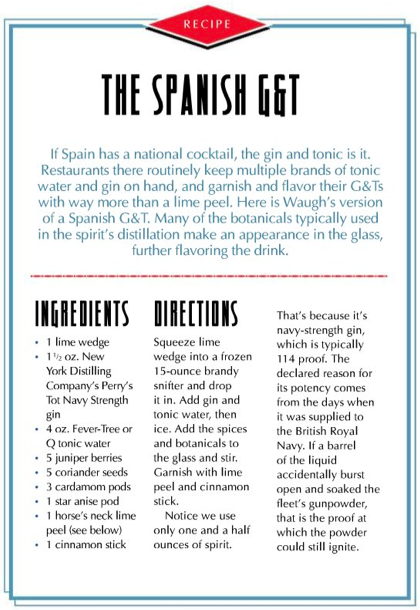He just married the girl of his dreams. And his dream of being a fashion designer? That’s coming true now, too. Oh, and there’s also a new album on the way. So what comes after being the most confrontational man in America?
Tag Archives: clothes
Guitar Hero India Reynolds
YAMI GAUTAM – BARES HER SHOULDERS & WRISTS
On bikinis, sperm donors, political correctness and hopeless flirting.
 The next time your father gives you one of those ‘impossible is nothing’ lines ask him to convince Yami Gautam to pose in a bikini for FHM, or for that matter even for a sequence in Steven Speilberg’s film! In over ten different ways, we coaxed her to say yes to wear bikini, but she refused to budge. “NO. I won’t wear a bikini. Not even for Steven Speilberg. If he ever approaches me for a film, it will be more on the basis of my acting skills, and not on the basis of the two-piece.”
The next time your father gives you one of those ‘impossible is nothing’ lines ask him to convince Yami Gautam to pose in a bikini for FHM, or for that matter even for a sequence in Steven Speilberg’s film! In over ten different ways, we coaxed her to say yes to wear bikini, but she refused to budge. “NO. I won’t wear a bikini. Not even for Steven Speilberg. If he ever approaches me for a film, it will be more on the basis of my acting skills, and not on the basis of the two-piece.”
 It’s her denial that has kept her away from FHM and those Google pictures searches of her chaste. “I was apprehensive about shooting with FHM, the clothing part worried me a bit. If I shoot with FHM, I should be able to do justice to your content and in some way add to your immense popularity. If I am not able to do that, what’s the point of me being on the cover! I am not comfortable with the bikini image because that’s not what I am. Also, I didn’t want to portray myself as someone who is desperate for being called a ‘hot chick’ because you guys have helped a lot of women break their stereotypes. Being on your cover is of great importance and I didn’t want to take it lightly. So, we had to come to a consensus where you get something hot, and I get to keep my existing image intact.”
It’s her denial that has kept her away from FHM and those Google pictures searches of her chaste. “I was apprehensive about shooting with FHM, the clothing part worried me a bit. If I shoot with FHM, I should be able to do justice to your content and in some way add to your immense popularity. If I am not able to do that, what’s the point of me being on the cover! I am not comfortable with the bikini image because that’s not what I am. Also, I didn’t want to portray myself as someone who is desperate for being called a ‘hot chick’ because you guys have helped a lot of women break their stereotypes. Being on your cover is of great importance and I didn’t want to take it lightly. So, we had to come to a consensus where you get something hot, and I get to keep my existing image intact.”
 That’s for the bad news, the good news is that the 25-year-old isn’t under some lifetime oath to wear clothes that cover her wrists and ankles. “People change so do their opinions, so I wouldn’t really say that I will never wear a bikini, but as of now, it’s a dead NO.” For Now. Yes, we did add the ‘for now’. Yami is not new to the FHM fold, she has been pretty clued to our covers. “I loved every cover of Katrina Kaif. Also, the one that you guys shot with Nargis was brilliant.”
That’s for the bad news, the good news is that the 25-year-old isn’t under some lifetime oath to wear clothes that cover her wrists and ankles. “People change so do their opinions, so I wouldn’t really say that I will never wear a bikini, but as of now, it’s a dead NO.” For Now. Yes, we did add the ‘for now’. Yami is not new to the FHM fold, she has been pretty clued to our covers. “I loved every cover of Katrina Kaif. Also, the one that you guys shot with Nargis was brilliant.”
As for work, the Himachal born, Chandigarh bred girl is completely focused, she is busy like never before and is still fine-tuning herself to the slaving life of Mumbai. Infact, she is so busy that this interview of hers was rescheduled thrice from happening at 10.30 am on a Sunday to late in the evening that day and finally happened at 3.45 on a Monday. When we finally spoke to her she was travelling to Pune. “I am now living every word of those interviews that I read of film stars about how Mumbai occupies you completely. I know it sounds like a cliché, but I am never not occupied in something or the other.” Even in her prayers, something that is as much part of her daily routine as rushing from one shoot to another, all she does is pray about getting more and more work.
 Yami has come a long way in her life from her initial appearances in television commercials and soap operas your mother watches. She has also gotten way past the stage of thinking being called ‘Yummy is cute’. “Oh God! Calling me Yummy is so cheesy. I am used to of being called Yami to Yummy to Yemen from school days, so I have given up. When I was in school, I would fear my name being announced on the stage because the boys would later take my trip. In fact, a childhood friend called me Yemen, I don’t why, but she did.”
Yami has come a long way in her life from her initial appearances in television commercials and soap operas your mother watches. She has also gotten way past the stage of thinking being called ‘Yummy is cute’. “Oh God! Calling me Yummy is so cheesy. I am used to of being called Yami to Yummy to Yemen from school days, so I have given up. When I was in school, I would fear my name being announced on the stage because the boys would later take my trip. In fact, a childhood friend called me Yemen, I don’t why, but she did.”
Yet somehow, for someone who made a huge splash with her debut film Vicky Donor she’s had a slightly uneventful couple of years. Her next movie after Vicky Donor, Total Siyappa tanked at the box office, but such is her hold on the audience that they have now moved their attention and expectation to her next release Action Jackson, which co-stars Ajay Devgan, Sonakshi Sinha and Kunal Roy Kapoor.
 She hasn’t forgotten how much of her success she owes to VD, “I wouldn’t have been on your cover if Vicky Donor wasn’t my film. Everything that I have today is because of Shoojit. Working with him will always be my priority.” As for other film that she is currently filming, there is no point talking about them because everything has to be protected like Nuclear launch codes, so we picked on her for the flak that she received on twitter for endorsing fairness creams, “Endorsing a fairness product isn’t debatable nor do I need to defend it. I endorse them because that’s my job. Whether a celeb uses a product that he endorses or not completely depends on them,” she shoots us down.
She hasn’t forgotten how much of her success she owes to VD, “I wouldn’t have been on your cover if Vicky Donor wasn’t my film. Everything that I have today is because of Shoojit. Working with him will always be my priority.” As for other film that she is currently filming, there is no point talking about them because everything has to be protected like Nuclear launch codes, so we picked on her for the flak that she received on twitter for endorsing fairness creams, “Endorsing a fairness product isn’t debatable nor do I need to defend it. I endorse them because that’s my job. Whether a celeb uses a product that he endorses or not completely depends on them,” she shoots us down.
45 minutes down the interview, we asked her something we’ve been itching to for a while – would she date someone who is a sperm donor, only to have her freak out mid question. “I would never date anyone who donates sperms to earn money, might still consider someone who does it for charity. When the script of Vicky Donor was being read out to me, I was just saying ok…ok…okay and even the narrator was giggling all the while. I came back home and I told my mom about the film and even she was like ‘okay’. No one knew how to react, so you can understand why dating a sperm donor isn’t as cool as you think.”
 And what are the other kinds of men you will never date? “I can never be with a man who fantasises about Carmen Electra, Cindy Crawford and Pamela Anderson.” This is where the conversation got a bit doozy for us because as you know there is Carmen Electra heating up the front of the book as the Access Girl this month. But then full disclosure is for fools. “Certainly Ben Affleck. If there is an embodiment of how my man should be, it has to be Ben. If you are seriously match making then I would like to take things forward with someone who is a bit different from me, adventurous and open minded, but again, he shouldn’t be a Pam (Anderson) fan,” she says ruling out anyone born in the 80s.
And what are the other kinds of men you will never date? “I can never be with a man who fantasises about Carmen Electra, Cindy Crawford and Pamela Anderson.” This is where the conversation got a bit doozy for us because as you know there is Carmen Electra heating up the front of the book as the Access Girl this month. But then full disclosure is for fools. “Certainly Ben Affleck. If there is an embodiment of how my man should be, it has to be Ben. If you are seriously match making then I would like to take things forward with someone who is a bit different from me, adventurous and open minded, but again, he shouldn’t be a Pam (Anderson) fan,” she says ruling out anyone born in the 80s.
And what about the films that come to her, how does she select them. “Firstly, I look at my character, then the story and then the director.” But shouldn’t it be like story first, then the director and then the character. “Not really. A script may not always be impressive. A film like Barfi, do you think, it would have sounded as promising to the actors on the papers as it turned out to be?”
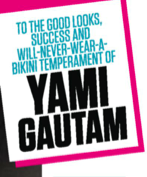 By the time we finished our chat, she had reached half way to Pune, we were still moping about bikinis and she was talking about how much she’d love to be in a remake of DDLJ. “It’s impossible to imagine DDLJ without him,” she says. We continue to mope about the bikini. Or the lack of it.
By the time we finished our chat, she had reached half way to Pune, we were still moping about bikinis and she was talking about how much she’d love to be in a remake of DDLJ. “It’s impossible to imagine DDLJ without him,” she says. We continue to mope about the bikini. Or the lack of it.
Sex, Slavery and a Slippery Truth
SOMALY MAM: THE HOLY SAINT (AND SINNER) OF SEX TRAFFICKING. SOMALY MAM SAVED COUNTLESS GIRLS IN CAMBODIA. DOES IT MATTER IF KEY PARTS OF HER STORY AREN’T TRUE?
Nestled on the banks of the Mekong River, Thloc Chhroy looks like the typical rural Cambodian village. Mango trees thick with fruit are everywhere. Fishermen cast their nets from small motorboats. Elders lounge in hammocks, while children on bikes too big for them bounce along rutted dirt tracks.
But this is no ordinary village. Every now and then, a shiny four-wheel drive bounces down the dirt track that leads to a refuge center of an organization whose name in French is Agir Pour Les Femmes en Situation Précaire, or AFESIP. (Rough translation: Helping Women in Danger.) Inside the vehicle you may spot a powerful government official, a heavyweight journalist or even an American movie star. They all come to meet with AFESIP’s president and co-founder, Somaly Mam, and support her courageous work fighting sex traffickers.
Mam is one of the world’s most compelling activists, brave and beautiful, and her list of supporters is long and formidable. Former U.S. secretary of state Hillary Clinton and actresses Meg Ryan, Susan Sarandon and Shay Mitchell, as well as New York Times Pulitzer-winning columnist Nicholas Kristof, have all toured AFESIP centers in Cambodia. Queen Sofia of Spain has for years promoted Mam’s cause and even visited her in the hospital last year when she fell ill. Mark Zuckerberg’s former
PR guru, Brandee Barker, whom The New York Times recently described as “perhaps the most sought-after image consultant in the startup world,” is a board member for the Somaly Mam Foundation, and Facebook Chief Operating Officer Sheryl Sandberg is an advisory board member.
Mam has raised millions with a hectic schedule of meetings all over the globe with the good, the great and the super-rich—from the U.N.’s Ban Ki-moon to the pope. One day she will be speaking at the White House, and the next day she’ll be enthralling schoolchildren in a remote corner of Cambodia.
Mam claims to have rescued thousands of girls and women from sex trafficking, a dangerous and formidable feat. Her story becomes even more inspiring when you hear her shocking tale of being sold into sexual slavery. In 2005, she published her autobiography, The Road of Lost Innocence, which became an international best-seller. Mam was one of Time’s 100 most influential people in 2009 and has over 400,000 followers on Twitter.
She has done so much for so many, does it matter that key parts of her story aren’t true? This is a story about a story—but not quite the amazing one Mam has been telling at cocktail parties in Manhattan and Beverly Hills, or on The Tyra Banks Show. Nonetheless, it’s an astonishing tale.
Book of a Genesis
 In 2011, Mam sat down with Sandberg at Fortune magazine’s Most Powerful Women summit and told the hushed audience what had motivated her to become a crusader against sexual slavery. “I have been sold in the brothel by the man who come and tell me that he’s my grandfather,” she said. “I stayed in the brothel nearly then 10 years. The brothel owner bring us all together, we all sit on the ground, and he tell us we have to do what he ask us to do. But one girl…she refused to do what he asked to do so he take a gun and kill her, so that is the day that I have been escaped from the brothel.”
In 2011, Mam sat down with Sandberg at Fortune magazine’s Most Powerful Women summit and told the hushed audience what had motivated her to become a crusader against sexual slavery. “I have been sold in the brothel by the man who come and tell me that he’s my grandfather,” she said. “I stayed in the brothel nearly then 10 years. The brothel owner bring us all together, we all sit on the ground, and he tell us we have to do what he ask us to do. But one girl…she refused to do what he asked to do so he take a gun and kill her, so that is the day that I have been escaped from the brothel.”
Mam declined to be interviewed by Newsweek for this article and has declined numerous requests for comment since I started reporting on inconsistencies in her stories in 2012. But she has repeatedly claimed that her tragic tale of abuse began in 1979 with a voyage through the rolling hills of Mondulkiri, a part of Cambodia that back then was still dense forest. Accompanied by a man she identifies only as “Grandfather,” she trundled passed stilted homes inhabited by tribal villagers and forests that were home to sacred spirits.
In her autobiography, Mam tells how “Grandfather” turned her at a very young age into his domestic slave. He would gamble and drink, and when he came home, he sometimes beat her until she bled. He eventually sold her as a virgin to a Chinese merchant and then forced her to marry a violent soldier when she was just 14. She was later sold to a brothel in Phnom Penh, where she recalls being tortured with electrodes hooked up to a car battery.
But after years of servitude, Mam writes, the brothel owner, Aunt Peuve, began to give her more freedom. She still worked in the brothel, but she sometimes lived with some of the foreigners working for the plethora of humanitarian organizations that rushed in to help the country recover from the depredations of the Khmer Rouge. In 1991, she met Pierre Legros, a young Frenchman working as a biologist in Phnom Penh. This meeting, she writes, changed her outlook on life and convinced her to leave the world of prostitution for good.
She and Legros got married and moved to France in the early 1990s. Legros says he was amazed at how easily Mam took to life in Europe. “She found a job as a maid. She found a job before me. She handled the situation very quickly…. It was the Somaly that I knew. It was a woman, a warrior. She was a small warrior. I worked with her and made a big warrior out of her.”
In 1994, they returned to Cambodia. Legros had found a job working for Doctors Without Borders, and Mam began doing volunteer work in one of the organization’s clinics for patients with sexually transmitted diseases. Cambodia then had a sex trafficking crisis and the highest rate of HIV/AIDS in the Asia-Pacific region. Mam says her past and future were staring her in the face: Her destiny, she decided, would be to help girls escape her country’s notorious brothels. Mam, Legros and a friend started AFESIP, a small but feisty nongovernmental organization.
Mam and Legros were an intrepid and attractive couple fighting for the most worthy of causes, and the media soon began to take an interest. At first they were hard-pressed for cash, but a France 2 documentary broadcast in 1998 gave AFESIP major exposure and helped get Mam chosen as one of seven celebrated women honored with the prestigious Prince of Asturias Award for International Cooperation. Among the other winners were Emma Bonino, a former European commissioner for humanitarian aid, and Olayinka Koso-Thomas, a Nigerian-born doctor who had campaigned for decades against the genital mutilation of women.
Legros was now thinking big, far beyond the borders of Cambodia: AFESIP satellites offices were opened in Laos, Thailand, Vietnam, France and Switzerland. He knew that Mam needed more media exposure if their grand ambitions were to be achieved. “We knew that the visibility on television is very short-lived. You’re known and then you disappear. I always said to Somaly, ‘The real thing to do after the television is to write a book.’”
After Mam made a televised appearance with Bonino in the early part of the past decade and talked about her own story, several publishers expressed interest in a book deal. Legros recalls that an agent working for one publishing house in Paris burst into tears while listening to Mam tell her story in her office. Published in France in 2005; published in America three years later, The Road of Lost Innocence was translated into Japanese, Swedish and over a dozen other languages.
About a year later, Mam set up the Somaly Mam Foundation, the next step in her long journey to international recognition. As the years went by, Mam and her organization went from triumph to triumph, bringing in more and more money. Mam is now a superstar in the mostly gritty world of nonprofits, and a jet-setting global icon, but she always insists that her real life is with her “girls” back in Phnom Penh.
A Chilling Performance
 Mam has done much for those girls, and a few of them have done much for her. Mam’s success has been due to her energy, her fearlessness and her charisma. It is also due to the shocking stories she and her girls have told.
Mam has done much for those girls, and a few of them have done much for her. Mam’s success has been due to her energy, her fearlessness and her charisma. It is also due to the shocking stories she and her girls have told.
In 2009, Nicholas Kristof wrote in The New York Times about a girl named Long Pross, who had finally summoned the strength to tell her stunning story of sexual slavery. He reported that a woman had kidnapped Pross and sold her to a brothel, where she was beaten, tortured with electric wires, forced to endure two crude abortions and had an eye gouged out with a piece of metal by an angry pimp. Pross, Kristof said, was rescued by Mam and became part of her valiant group of former trafficking victims fighting for a world free of sexual slavery.
Pross also told her disturbing story on Oprah and appeared in the PBS documentary Half the Sky. “Believe it or not, when I returned home, my mother and father didn’t want me around. I wasn’t considered a good person,” she says in the documentary.
Equally hard to believe is the fact that Pross’s family, neighbors and medical records all tell a different story. Dr. Pok Thorn says he performed surgery on Pross when she was 13, after her parents brought her to a hospital with a nonmalignant tumor covering her right eye. Photographs in her medical records clearly show the young girl’s eye before and after the surgery.
So how did she come to be one of Somaly Mam’s girls? Te Sereybonn, director of Cambodia’s Takeo Eye Hospital back then, says his staff contacted AFESIP to see if they could admit Pross to one of their vocational training programs.
Another of Mam’s biggest “stars” was Meas Ratha, who as a teenager gave a chilling performance on French television in 1998, describing how she had been sold to a brothel and held against her will as a sex slave.
Late last year, Ratha finally confessed that her story was fabricated and carefully rehearsed for the cameras under Mam’s instruction, and only after she was chosen from a group of girls who had been put through an audition. Now in her early 30s and living a modest life on the outskirts of Phnom Penh, Ratha says she reluctantly allowed herself to be depicted as a child prostitute: “Somaly said that…if I want to help another woman I have to do [the interview] very well.”
She, like Pross, was never a victim of sex trafficking; she and a sister were sent to AFESIP in 1997 because their parents were unable to care for all seven of their children.
Lost Innocence
 Interviews with Mam’s childhood acquaintances, teachers and local officials in the village where she grew up contradict important, lurid details in her autobiography. Many of the villagers in Thloc Chhroy say they never met or even saw Mam’s cruel “Grandfather,” the rich Chinese merchant who allegedly raped her or the violent soldier she says she was forced to marry.
Interviews with Mam’s childhood acquaintances, teachers and local officials in the village where she grew up contradict important, lurid details in her autobiography. Many of the villagers in Thloc Chhroy say they never met or even saw Mam’s cruel “Grandfather,” the rich Chinese merchant who allegedly raped her or the violent soldier she says she was forced to marry.
Orn Hok, a former commune chief, remembers well the day Mam arrived in the village, noting, “Somaly came here with her parents. She is a daughter of Mam Khon and Pen Navy.”
Pen Chhun Heng, now in her 70s, says she is a cousin of Mam’s mother and rejects the notion that Mam was adopted or that she was raised (or kept) by “Grandfather.”
Sam Nareth, a childhood friend of Mam’s, says Mam first attended school in the village in 1981 and remained there until she got her high school diploma. “She finished secondary school in 1987, and Somaly and I went to sit the teachers exam in Kompong Cham together.”
Thou Soy, who was the director of Khchao High School in Thloc Chhroy, distinctly remembers Mam attending classes between 1981 and 1987, as does the current commune chief, Thorng Ruon, and his two predecessors. Mam was well-known and popular in their small village, a happy, pretty girl with pigtails.
Not even Mam can keep the story straight. In February 2012, while speaking at the White House, she said she was sold into slavery at age 9 or 10 and spent a decade inside a brothel. On The Tyra Banks Show, she said it was four or five years in the brothel. Her book says she was trafficked when she was “about 16 years old.”
Mam’s confusion isn’t limited to her book, or the backstory for some of “her girls.” In 2012, she admitted —after being confronted with some of my early reporting —that she had made false claims in a speech to the U.N. General Assembly in which she said eight girls she had rescued from the sex industry were killed by the Cambodian army after a raid on her shelter in 2004.
Rights workers and police officials, including Deputy National Police Chief Lieutenant General Un Sokunthea, who was head of the Interior Ministry’s anti-human trafficking department in 2004, and a senior official at the U.N.’s Office of the High Commissioner for Human Rights in Phnom Penh, have also strongly denied highly publicized claims by Mam, in Glamour magazine and The New York Times, that traffickers kidnapped her 14-year-old daughter in 2006 and videotaped the girl being gang-raped in retaliation for Mam’s work. Legros and Aarti Kapoor, a former legal adviser to AFESIP, both say the young girl was never kidnapped; instead, they say, she had run away from home with her boyfriend.
Legros, who split from Mam in 2004 and lost custody of their children in Cambodia, now says he is not surprised that the truthfulness of her autobiography is being questioned. And although he brokered the book deal and selected the ghostwriter, he denies helping Mam make up her stories. He adds, however, that “I did not search the truth. My objective was that she felt good with herself.”
Mam Dearest
 Many of the people who have been charmed by Mam refuse to believe that she is anything other than what she claims to be. They talk of how inspiring she is and how holy her mission is. Fashion photographer Norman Jean Roy, who in 2008 documented Cambodia’s sex trade and shot some heartrending portraits of Long Pross, once said of Mam, “One of the things that’s unique about her is that she has this almost saint-like quality about her when she walks into a room, when she walks around the children.”
Many of the people who have been charmed by Mam refuse to believe that she is anything other than what she claims to be. They talk of how inspiring she is and how holy her mission is. Fashion photographer Norman Jean Roy, who in 2008 documented Cambodia’s sex trade and shot some heartrending portraits of Long Pross, once said of Mam, “One of the things that’s unique about her is that she has this almost saint-like quality about her when she walks into a room, when she walks around the children.”
But those who have worked with Mam in Cambodia say there is a vast difference between the image she puts forward in the media spotlight and the one she shows in Phnom Penh. “[With donors], she’s very polished and very on and very charming…exceedingly charming,” says Candace Blase, who worked as a volunteer psychologist for AFESIP in 2011. “And when people are not there, she can be tyrannical; she’s moody, she’s erratic, she’s entitled.” Blase adds that she saw Mam ordering the girls she looks after to carry out personal chores for her.
Another former employee of the Somaly Mam Foundation in Cambodia recalls conversations with Mam in which she said she was invincible. “She feels unstoppable. She used to talk to me about wanting to put things in people’s food and how easy it would be to poison someone.
“It was such a traumatic and hostile environment,” the former employee continues. “We were treated very much in a hostile and aggressive way. You’re either part of the group or you’re not, and if you’re not part of the group, bad things can happen to you. And that was said in sometimes very direct terms.”
Former employees in Cambodia of both AFESIP and the foundation admit they knew about some of the questionable techniques used to raise awareness and funding, but they say nobody spoke up due to a mixture of fear of Mam and threats from others. “Why does everybody keep quiet about everything?” Blase asks. “I think it’s very hard to accept that a woman who is in a nurturing position, which she sort of is, has the capacity to be the way Somaly is…. People keep their mouths shut because it’s in their own self-interest to do so.”
Daniela Papi, founder of PEPY, an organization that promotes education and youth leadership, argues that those doing heroic aid work become immune to criticism. “Most people want to believe that people are good,” she says. “We see this hero and we buy into the hero, and actually the person we are defending is ourselves. It’s not them anymore, it’s yourself for being duped.”
According to a close acquaintance of Mam’s in Phnom Penh, who insisted on remaining anonymous for fear of retribution, there have been doubts about Mam’s life story for years, but “it’s all about image, getting to the big shot who has a lot of money and who feels sorry for this kind of story. They’re very successful, and they have been very successful in an incredible way because they connect with the right people, and they have all the movie stars, famous rock stars and famous people supporting them, and [all those people] are still being taken for a ride now.”
“Pull Out the Most Gory Story”
At the heart of the questions surrounding Mam is a debate within the nonprofit sector on the acceptable tactics for fundraising and educating the public. For a long time, there has been a strong push to move away from using children to raise funds. “If your goal is fundraising, you actually have an incentive to pull out the most gory story,” Papi explains, “and so we get completely false realities of the world.”
Experts in sex trafficking say that while it is a serious problem, the scale and dynamics of the situation are often misunderstood, in part because of lurid, sensationalistic stories such as those told by Mam and her “girls.” In 2009, 14 organizations and academics, including George Soros’s Open Society Foundations, wrote a letter to Salty Features, an independent film production company based in New York, to thank it for its interest in making a film about Mam’s work in Cambodia.
But they advised against having the documentary focus on Mam due to AFESIP’s lack of understanding of the sex industry. In an interview for Euronews in 2012, Mam said girls as young as 3 are being held in Cambodian brothels. Experts in the field say that is almost unheard-of. Patrick Stayton, who formerly ran the Christian, faith- based International Justice Mission (IJM) in Cambodia, says, “They may have had a supply of younger girls between the age of 14 and 17,” but adds, “We’ve never seen prepubescent girls, or very, very rarely.”
“[O]ver the last 10 years, the public justice system’s response to commercial sexual exploitation of children has improved significantly,” IJM stated in a report last year, noting a huge difference in donor funding for projects dealing with child victims of the sex industry and sexual abuse. “The decrease has been noted most within the group of young minors.”
Thomas Steinfatt, a professor of statistics at the University of Miami, has done several reports on sex trafficking for the U.N.’s Inter-Agency Project on Human Trafficking. In a 2008 study, for which he spent months conducting surveys in all corners of Cambodia, he estimated there were no more than 1,058 victims of trafficking in Cambodia and has said the situation has improved markedly since then.
The number of children, both those observed as sex workers and those mentioned by management or by sex workers in the 2008 data, was 127, with 11 of the children verifiably under age 15 and six under age 13. The high-end estimate for the number of children likely involved in sex work in Cambodia in 2008 was 310 children.
In response to a newspaper story about victim stories allegedly fabricated by Mam, Sébastien Marot, the executive director of Friends International, an organization that helps train and educate children in precarious situations, posted a response on the organization’s website: “A large number of organizations get sucked into using children to raise funds: making them talk about the abuse they survived in front of a camera, having their picture in a pitiful situation published for everyone to see. In worst cases, the truth is distorted or the stories invented to attract more compassion and money. The impact on the lives of these children is terrible: If they come from an abusive situation, such a process re-traumatizes them and in any case it stigmatizes them forever.”
A Crack in the Wall
I have spent over two years in Europe and Cambodia unraveling Mam’s many stories through a series of newspaper articles, and for most of that time, she, AFESIP and her foundation have stonewalled. They have resolutely stood behind their leader, their hero. It was only in the past two months, while I was reporting this story, that cracks started to appear.
In April, after repeated requests from Newsweek for an interview with Mam, Gina Reiss-Wilchins, the foundation’s executive director, said in a statement on the foundation’s website: “Following an internal review, the Foundation has recently launched an independent, third-party investigation to further examine these claims. Somaly Mam is in full support of this review. We can only hope that this does not deter other survivors from sharing their experiences, because it is their courageous voices that bring promise of a world free from trafficking.”
The foundation’s board retained the law firm Goodwin Procter, which has offices in the U.S., Europe and Asia. The firm also declined to speak to Newsweek, citing attorney- client privilege. Goodwin Procter and the Somaly Mam Foundation also declined to say when the investigation would be completed and if the results would be shared.
In April, Mam spoke to her supporters about the controversies swirling around her in a statement posted on the foundation’s website. “Many of you know my story of what I have been through. This pain never leaves me…. I have lived my life day by day, with love and forgiveness, and the belief that helping others could give them voice and choice and create change. I wrote my book to shed light on the lives of so many thousands of other women who have shared my fate. They have no voice, so I let my voice stand for theirs.”
That message still seems to resonate with many of the people who admire Mam. In October, a post on what purports to be her Facebook page said: “I Fall, I Rise, I Make Mistakes, I Live, I Learn, I’ve been Hurt, But I’m Alive, I’m Human and I’m not perfect but I learn every day and with every one to be better, but I promise you never perfect…teach and show me on the positive way…thanks.”
In response, one of her supporters wrote: “I’ve been there myself and though mistakes have been made along the way, they were often done so with a much more powerful intention…and that has proved true here. Those mistakes have led to helping so many people and bringing international attention to a VERY serious problem…kudos to you!”
Playmate Bernadette
Public Enemy Number One – Al Capone
Arriving in Chicago as a minor league mobster, Al Capone helped build an empire of prostitution, bootlegging and murder that made him a notorious household name.
The needle skipped as the gun barked twice in the killer’s hand, the record player screeching into the silence of the restaurant’s corridor as its owner crashed to the floor, blood pooling out onto the polished tiles.
Giacomo ‘Big Jim’ Colosimo, his body cooling from its exit wounds, had recently left his wife, filing for divorce and skipping town to marry a 19-year-old cabaret singer. His ex-wife, Victoria Moresco, or one of her brothers, was the prime suspect in this crime of passion, but the police knew enough to pay a visit to two of Colosimo’s associates – the genial Johnny Torrio and his sidekick, the disquieting Alfonse Capone, three nasty scars on his cheek contorting as he smiled. “Big Jim and me were like brothers,” claimed Torrio. “Mr Colosimo and me both loved opera”, added Capone. “He was a grand guy.” Colosimo’s murder on 11 May 1920 is still regarded as unsolved, but perhaps it’s a crime that Chicago Police Department chose to leave that way. For nearly a decade Colosimo had ruled Chicago through hard graft and intimidation – running over 100 brothels with his wife – and extorting protection money from most of the city’s illegal gambling dens, the profits snaking through the entire city, supplementing the meagre wages of the cop on the street corner and boosting the bank account of the city’s two-time mayor, William ‘Big Bill’ Hale Thompson.
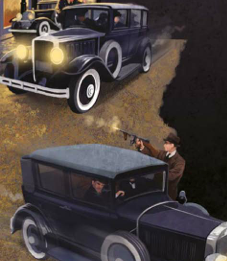 Chicago was a rough town. Booming in the early 1920s thanks to heavy industry and cheap labour, the Windy City was a Wild West frontier town with chimney stacks instead of cacti and bullet- riddled Model-T Fords in lieu of horses. “She was vibrant and violent,” wrote local journalist Robert St John, “stimulating and ruthless, intolerant of smugness, impatient with those either physically or intellectually timid.”
Chicago was a rough town. Booming in the early 1920s thanks to heavy industry and cheap labour, the Windy City was a Wild West frontier town with chimney stacks instead of cacti and bullet- riddled Model-T Fords in lieu of horses. “She was vibrant and violent,” wrote local journalist Robert St John, “stimulating and ruthless, intolerant of smugness, impatient with those either physically or intellectually timid.”
Capone had arrived in Chicago from New York in 1919 to work for his old friend Torrio, who had earned Colosimo’s trust by chasing off a rival extortion racket and stuck around as the boss’s second in command. Capone soon put the feared reputation he had enjoyed back home to work as a debt collector, seeing first hand how Colosimo’s operation held a stranglehold over the underworld; gambling dens who refused to pay up for Big Jim’s protection would either find themselves the subject of a convenient police raid or – worse still – a visit from Capone, who was more than happy to break a few legs and mess up a card table with a swing from his baseball bat.
 Compared to the claustrophobic Big Apple, where half a dozen gangs butted heads over a block at a time, Torrio and Capone found Chicago fertile for expansion, as the only thing that stood in their way was their own boss. In January 1920 the rules of the game changed again as the 18th Amendment to the US Constitution came into effect. Also known as the Volstead Act, which prohibited the production, transportation and sale of alcohol – but not the consumption – Prohibition meant a huge swathe of the population were suddenly transformed into potential customers. Torrio and Capone saw that this was a revenue stream with the potential to dwarf even prostitution and racketeering, but to their dismay Colosimo was having none of it. When Colosimo was conveniently removed from the picture, John ‘The Fox’ Torrio became the boss of the Chicago
Compared to the claustrophobic Big Apple, where half a dozen gangs butted heads over a block at a time, Torrio and Capone found Chicago fertile for expansion, as the only thing that stood in their way was their own boss. In January 1920 the rules of the game changed again as the 18th Amendment to the US Constitution came into effect. Also known as the Volstead Act, which prohibited the production, transportation and sale of alcohol – but not the consumption – Prohibition meant a huge swathe of the population were suddenly transformed into potential customers. Torrio and Capone saw that this was a revenue stream with the potential to dwarf even prostitution and racketeering, but to their dismay Colosimo was having none of it. When Colosimo was conveniently removed from the picture, John ‘The Fox’ Torrio became the boss of the Chicago
Outfit, and by his side stood Al Capone. With Torrio’s blessing, Capone set about covertly reopening breweries and distilleries that had been closed by the Volstead Act, setting up an ambitious distribution network to the city’s mean speakeasies with the help of his older brothers Ralph and Frank Capone. “Nobody wanted Prohibition,” he said. “This town voted six to one against it. Somebody had to throw some liquor on that thirst. Why not me?”
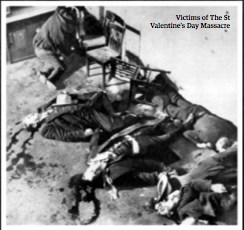 The loyal Ralph was put in charge of one of the Chicago Outfit’s legal enterprises, a soft-drink bottling plant which earned him the nickname ‘Bottles’, while Frank honed a reputation for savagery that overshadowed even Al’s. Estimated to have been responsible for 300 deaths, Frank infamously advised his little bother that, “you get no talk back from a corpse.”
The loyal Ralph was put in charge of one of the Chicago Outfit’s legal enterprises, a soft-drink bottling plant which earned him the nickname ‘Bottles’, while Frank honed a reputation for savagery that overshadowed even Al’s. Estimated to have been responsible for 300 deaths, Frank infamously advised his little bother that, “you get no talk back from a corpse.”
It was happening under Johnny Torrio’s command but there was no doubt that bootlegging was Al Capone’s kingdom, and he was soon to pay for it in blood as 1923 saw the downfall of Chicago’s sticky fingered mayor, ‘Big Bill’ Thompson. The Democrat William Emmett Dever was voted in on a pledge to sweep the gangs from the city, and Torrio entrusted Capone with an urgent relocation to Cicero – the
fourth largest city in Illinois – just outside of Chicago and the legislative reach of ‘Decent Dever.’ While Torrio and Capone had ruled their criminal empire largely as Colosimo had – with money in the right pockets and threats whispered in the right ears – the takeover of Cicero was an overt display of force, as Capone set about rigging the mayoral election for the mob’s pet politician, Joseph Z Klenha.
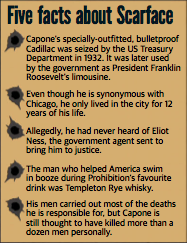 On the eve of the 1924 mayoral election, Frank Capone burst into the office of the Democrat candidate for Cicero with some of his thugs, beating the hopeful to a pulp with their pistol butts, trashing his office and firing their revolvers into the ceiling as a preamble for the next day’s audacious takeover. As cold, grey 1 April dawned, Capone hoods stormed into the polling stations to screen voters, snatching their ballot papers from them to ensure they were ticking the right box. Election officials with the stones to intervene were dealt with; a Democrat campaign worker was shot in the legs and dumped in a cellar, two other men were shot in the street and another had his throat cut.
On the eve of the 1924 mayoral election, Frank Capone burst into the office of the Democrat candidate for Cicero with some of his thugs, beating the hopeful to a pulp with their pistol butts, trashing his office and firing their revolvers into the ceiling as a preamble for the next day’s audacious takeover. As cold, grey 1 April dawned, Capone hoods stormed into the polling stations to screen voters, snatching their ballot papers from them to ensure they were ticking the right box. Election officials with the stones to intervene were dealt with; a Democrat campaign worker was shot in the legs and dumped in a cellar, two other men were shot in the street and another had his throat cut.
Eventually, a desperate judge bussed in 70 Chicago police officers, deputised on the spot into the Cicero Police Department, to restore order. As the rain started to fall, Frank Capone found himself in a firefight outside a polling station. Opening fire on an approaching police car, he was gunned down by the startled cops, but it was too late – the town belonged to the Chicago Outfit. Frank got a funeral fit for war hero, with $20,000 worth of flowers placed around the silver plated coffin and over 150 cars in the motorcade.
 Despite the appalling bloodshed in the takeover of Cicero, Al Capone had been something of an enigma to the press. However, as he got his hands dirtier and dirtier and frequently acted unstably – a possible consequences of syphilis contracted back in New York – his name was beginning to be heard outside of darkened back rooms where shady men made deals. A few weeks after Frank’s body hit the pavement, small- time burglar ‘Ragtime’ Joe Howard was enjoying a drink in a bar, when two men entered. Witnesses, who quickly forgot all the other details, recalled him say a friendly “Hello Al” before he was shot point blank – four rounds into his cheek and two into his shoulder. Nobody saw anything, nobody recognised the man, but the police knew who was responsible and so did the press, so for the first time, Capone’s mugshot appeared on the front page.
Despite the appalling bloodshed in the takeover of Cicero, Al Capone had been something of an enigma to the press. However, as he got his hands dirtier and dirtier and frequently acted unstably – a possible consequences of syphilis contracted back in New York – his name was beginning to be heard outside of darkened back rooms where shady men made deals. A few weeks after Frank’s body hit the pavement, small- time burglar ‘Ragtime’ Joe Howard was enjoying a drink in a bar, when two men entered. Witnesses, who quickly forgot all the other details, recalled him say a friendly “Hello Al” before he was shot point blank – four rounds into his cheek and two into his shoulder. Nobody saw anything, nobody recognised the man, but the police knew who was responsible and so did the press, so for the first time, Capone’s mugshot appeared on the front page.
In private, Capone’s gang whispered that Howard had stuck up Jack ‘Greasy Thumb’ Guzik for $1,500, boasting he had “made the little Jew whine.” Guzik was Capone’s trusted money man, responsible for regular payoffs to cops and judges. Soon the name ‘Scarface’ began to stick, needling away at Capone’s vanity – he never allowed the left side of his face to be photographed – and he began to lash out at the flickering flash bulbs of the photographers.
There were far more immediate threats than damning headlines, though. The predominantly Irish-American North Side Gang run by Dean O’Banion controlled the breweries and the bootlegging in Chicago’s North Side and had resisted all of Torrio’s efforts to bring them to heel. Alliances and truces had dwindled and fallen apart, but the last straw came on 19 May 1924 as O’Banion finally relinquished his share of the Sieben Brewery to Torrio. As soon as Torrio and his boys – joined by their allies in Little Sicily’s ‘Terrible Gennas’ – showed up, a conveniently timed police raid swept in and the boss was left with a $5,000 fine and a nine-month jail sentence. “Deany was all right,” smirked Capone, who took over the day-to-day running of the mob while Torrio served his sentence. “But like everyone else, his head got away from his hat.”
One day while O’Banion clipped chrysanthemums in his flower shop, Schofields, Mike ‘The Devil’ Genna, John Scalise, Albert Anselmi and Frankie Yale strode in. As O’Banion and Yale shook hands, Scalise and Anselmi fired two bullets into his chest and two into his throat. As he lay on the floor in a pool of blood and petals, he was shot in the back of the head for good measure. He had been dealt with.
George Clarence ‘Bugs’ Moran took over the North Side Gang and nursed their grudge, moving the headquarters from Schofields to the garage that would become the site of the shocking
St Valentine’s Day Massacre in 1929, the culmination of a brutal and bloody five-year gang war between the Chicago Outfit and the North Side Gang.
 Upon his release Torrio kept a low profile – safe in the knowledge that with Capone in the hot seat, he’d be less of a target. For all of the Fox’s wiles, he just hadn’t reckoned on how personal this war had become.
Upon his release Torrio kept a low profile – safe in the knowledge that with Capone in the hot seat, he’d be less of a target. For all of the Fox’s wiles, he just hadn’t reckoned on how personal this war had become.
Returning from a day shopping with his wife on the morning of 24 January 1925, gunfire lit up the street from a blue Cadillac lurking on the curb, shredding shopping bags to confetti. Blood mingled with the groceries from a litany of wounds as Johnny Torrio stared at the sky, the shrieking of Anna Torrio strangely distant. As Bugs Moran stood over him, blocking the crisp winter sun, his revolver levelled at Torrio’s skull – the gun clicked on empty and the would-be assassins fled.
Capone’s ascendancy was immediate as Torrio underwent emergency surgery. Capone slept by his mentor’s bedside – the men of the Chicago Outfit standing guard around the clock, eying each disinterested nurse and flower-clutching day visitor suspiciously. “It’s all yours, Al,” said Torrio eventually. “Me? I’m quitting. It’s Europe for me.”
 With the Fox quietly returning to Italy, Capone moved his headquarters into Chicago’s luxurious Lexington Hotel, taking over the fourth and fifth floors where he held court like an emperor, surrounded by mobsters and prostitutes. A concrete vault was installed in the basement and a secret staircase hidden behind a mirror in one of his bathrooms, just one part of a web of tunnels that would allow him a quick escape. Rising late most days, he took his time pouring over the morning papers like a statesman, before dressing himself in expensive finely tailored suits. Early afternoon, Capone moved
With the Fox quietly returning to Italy, Capone moved his headquarters into Chicago’s luxurious Lexington Hotel, taking over the fourth and fifth floors where he held court like an emperor, surrounded by mobsters and prostitutes. A concrete vault was installed in the basement and a secret staircase hidden behind a mirror in one of his bathrooms, just one part of a web of tunnels that would allow him a quick escape. Rising late most days, he took his time pouring over the morning papers like a statesman, before dressing himself in expensive finely tailored suits. Early afternoon, Capone moved
into his study in another suite where petitioners waited anxiously for favours and his patronage. Nobody talked about the “Free Kingdom of Torrio” anymore. No, now the press called Cicero the “Capital of Caponeland.”
Capone began to court newspaper men, handing out expensive cigars and inviting them to lavish parties, where the lord of the Chicago underworld played billiards with boxers, baseball players and the notoriously corrupt mayor of Chicago, Big Bill Thompson, miraculously re-elected in 1927. “Public service is my motto,” Capone explained to attentive reporters in December 1927. “99 per cent of the public in [Chicago] drink and gamble and my offense has been to furnish them with those amusements. My booze has been good and my games on the square.” Already the public had some sympathy for the bootleggers and Capone took hold of the notion and twisted it into the spectre of Robin Hood, portraying himself as heroic outlaw giving the people what they wanted.
 The bigger Capone’s business became, the more intricate and vulnerable the network of mobsters, bribes and alliances required to sustain it. It got to a point where the endemic corruption of Chicago’s law and government simply couldn’t be ignored. In the wake of the shocking St Valentine’s Day Massacre, Herbert Hoover was elected US president on an anti-corruption platform. His first move was to dispatch Prohibition agent Eliot Ness and a handpicked team of incorruptible ‘Untouchables’ to clean up Chicago’s streets by raiding Capone’s speakeasies and stills, and more importantly, it transpired, a team of IRS agents headed by accountant-turned-lawman Frank J Wilson with a mandate to turn over Capone’s finances for something that would stick in court.
The bigger Capone’s business became, the more intricate and vulnerable the network of mobsters, bribes and alliances required to sustain it. It got to a point where the endemic corruption of Chicago’s law and government simply couldn’t be ignored. In the wake of the shocking St Valentine’s Day Massacre, Herbert Hoover was elected US president on an anti-corruption platform. His first move was to dispatch Prohibition agent Eliot Ness and a handpicked team of incorruptible ‘Untouchables’ to clean up Chicago’s streets by raiding Capone’s speakeasies and stills, and more importantly, it transpired, a team of IRS agents headed by accountant-turned-lawman Frank J Wilson with a mandate to turn over Capone’s finances for something that would stick in court.
“Every time a boy falls off a tricycle, every time a black cat has gray kittens, every time someone stubs a toe, every time there’s a murder or a fire or the Marines land in Nicaragua, the police and the newspapers holler, ‘Get Capone!’“ raged Chicago’s premier gangster in his penthouse. “I’m sick of it.”
 As the gangster was having a tantrum, one of the men tasked with bringing him to justice was having second thoughts. “Doubts raced through my mind as I considered the feasibility of enforcing a law which the majority of honest citizens didn’t seem to want,” Ness admitted in his autobiography. “I felt a chill foreboding for my men as I envisioned the violent reaction we would produce in the criminal octopus hovering over Chicago, its tentacles of terror reaching out all over the nation. We had undertaken what might be a suicidal mission.”
As the gangster was having a tantrum, one of the men tasked with bringing him to justice was having second thoughts. “Doubts raced through my mind as I considered the feasibility of enforcing a law which the majority of honest citizens didn’t seem to want,” Ness admitted in his autobiography. “I felt a chill foreboding for my men as I envisioned the violent reaction we would produce in the criminal octopus hovering over Chicago, its tentacles of terror reaching out all over the nation. We had undertaken what might be a suicidal mission.”
While Capone wallowed in fine silks and syphilitic megalomania in his penthouse, Ness and his Untouchables began nipping at his heels – shutting down 18 stills and arresting 52 bootleggers in a single night. In the first six months alone, Ness’ daring raids had cost the Chicago Outfit an estimated $1,000,000, as well as some of loyal lieutenants, who now languished in jail for violations of the Volstead Act. He shrugged off Capone’s clumsy attempts at bribery, as well as two assassination attempts.
It was only ever an irritant, taking chunks out of his income and his pride – but to a mobster as egotistical as Capone, such defiance drove him into a rage. It was a fury Ness gleefully exploited – parading captured vehicles outside his hotel and taunting him on the phone. However much Ness might have damaged
CARMEN ELECTRA – 15 YEARS AFTER BAYWATCH
15 years on since Baywatch, Carmen Electra gets out of our highschool fantasies and into the magazine. Booyah.
Back in 1991, a 19-year-old dancer from Ohio moved to Hollywood to become a celebrity. Like every other bright-eyed and bushy- tailed teenage, hopeful, pitching up in Los Angele’s, with dreams of superstardom, Tara Leigh Patrick was convinced that she was the real deal. Since childhood, people had always told her she was destined for big success, and she believed it.
Tara Patrick was a brilliant dancer and a decent actress and singer. But she had the sort of face – and body – that doesn’t just turn heads, but makes grown men bite their fists. Most importantly, she possessed (in the language of the TV talent shows that hadn’t even been created then) what Simon Cowell would describe as the X factor – that magical aura of superstardom that only a lucky few emit.
Little did Tara know that she’d go on to become such a global megastar that some 20 years later, she’d be appearing as a judge on the world’s biggest TV talent shows, let alone dating the Lord Master of television, Simon Cowell, himself. But before all of that, before the red swimsuit and the Hollywood career spanning more than two decades, Miss Patrick had to change her name. Not her decision, but that of the pop legend, Prince, who first championed the artist who would thereafter be known as Carmen Electra.
“I was dancing for Prince in a nightclub called Glam Slam in LA .” says Carmen, like it’s no big deal at all. “Then I had the opportunity to audition for this all-girl group that he was putting together. I didn’t hear anything at first, so I assumed I didn’t get it, and I just kept working on demos. Then I remember receiving a call from him and he said, “I think you should be a solo artist. I don’t think you should be backing anyone up.” I couldn’t believe what I was hearing. It just blew me away for someone like him to believe in me at such a young age, at such an early stage in my career.”
Prince had so much faith in the teenager that once she’d changed her name, he gave her a solo record contract. Her debut album performed unspectacularly, but a star had been born, and from that moment on there was no stopping her. Besides helping make Baywatch one of the most iconic TV shows of all time (more on this later), Carmen has starred in some 42 movies. She has appeared on more FHM and Playboy covers than any other person in the world. She has been in The Pussycat Dolls. She has been married to and divorced basketball player Dennis Rodman and musician Dave Navarro. You name it, and it’s likely that over her 22-year career, Carmen has done it. Hell, she even has a fly named after her (the Carmenelectra shechisme) on account of her ‘splendid somal structure’ (aka banging body).
What is most remarkable is that through this roller-coaster life, Carmen has never really changed who she is. Which, given the accepted commandments of achieving longevity in showbusiness, is perhaps her biggest achievement of all.
ENDURANCE TEST
 The first rule of celebrity survival is that you must reinvent to remain famous. Trace a pop-cultural line from Madonna in the ’80s to Gaga and Cyrus today and you’ll find a trend: in order to stay relevant, most female performers have, at some point, undergone a radical metamorphosis. A change in hair colour, in style, in personality. Not selling enough records? Try twerking. Haven’t signed any big movie deals recently? Cut all your hair off. In Hollywood, reinvention is the cure for irrelevancy, an instant tonic for public indifference.
The first rule of celebrity survival is that you must reinvent to remain famous. Trace a pop-cultural line from Madonna in the ’80s to Gaga and Cyrus today and you’ll find a trend: in order to stay relevant, most female performers have, at some point, undergone a radical metamorphosis. A change in hair colour, in style, in personality. Not selling enough records? Try twerking. Haven’t signed any big movie deals recently? Cut all your hair off. In Hollywood, reinvention is the cure for irrelevancy, an instant tonic for public indifference.
There are, however, a very small number of celebrities who are so pop-culturally iconic, held in such high esteem across multiple generations, that reinvention isn’t necessary. Their appeal is themselves, not whatever their latest look or fad is. Not only does the public not need them to change, the public doesn’t want them to change. Over 20 years, Carmen Electra has stayed true to what made her so adored in the first place. “So badly, throughout my career, I’ve wanted to make drastic changes,” she says. “I’ve wanted to change my hair, my make-up, whatever. But when I’m hired, there’s a certain look that they want and it’s a look I’ve had for a long time.”
Carmen, has never really stopped being relevant. Critics will complain that she only gets jobs because of her looks and her boobs, but the public will continue to watch films she’s in and buy magazines she appears on the covers of.
While models model and singers sing, Carmen is a jack of all trades. She is, as much as anything else, a brand. You realise the extent of this when you talk to her at length – she’s as media-trained and savvy as a politician in an electoral campaign. You get a lot of, “I’m always grateful”s and “It’s important to be true to yourself”s, and it can be hard to really see the real Carmen Electra. It’s the Kate Moss approach: don’t say anything too opinionated, and you can’t piss anyone off.
But regardless of what she says in interviews, people will form an opinion and, in the Twitter age, this means putting up with plenty of abuse along with the praise.
“I usually stay away from Twitter because I feel like I want to do what I want to do and, after a while, when you’re constantly reading criticism, that can affect you.”
Does it affect you?
“I try not to let it. I want to be myself, I always want to be myself. I don’t want to change.”
Do your famous friends see what people are saying about them on Twitter?
“I have friends in the business and they read every single comment and they’ll be sad about it. I say, ‘Just don’t even pay attention. You’re part of social media, post what you want.’ Obviously, I really want to connect, especially on Instagram, and I do read some comments just so I can stay in the know, and connected. But it can be hard.”
LIFE BEGINS AT 40
 At 41, Carmen is officially the oldest Access Girl in FHM’s history – not that she looks it. Is
At 41, Carmen is officially the oldest Access Girl in FHM’s history – not that she looks it. Is
it harder modelling in your forties than in your twenties? “I feel more comfortable now,” she says. “Less nervous. I feel like I’m in a really good place in my life and just being in that space makes me feel sexier. FHM has supported me throughout my career.
“The secret to being sexy starts on the inside. I think it’s all about embracing yourself. I love being on shoots because you can get into the fantasy of it all. I love getting into new outfits, stuff I wouldn’t normally wear.”
Of course you can’t discuss outfits with Carmen Electra without bringing up that red swimsuit. The one that made her – as well as co-stars Pamela Anderson and Yasmine Bleeth – a global pop-culture icon. “I still have the red swimsuit,” Carmen proudly says of her famous Baywatch one-piece. “The whole Baywatch experience was just crazy, because it was such a new phenomenon at the time. It was really exciting and I learnt a lot on that show.”
Did she have to run in slow motion in the audition? “No, but I had to put the swimsuit on. I was really nervous. And then it all got a little weird: we all had to swim. It was definitely the most unusual audition I’ve ever done!”
Unusual it might have been, but Carmen nailed it, got the part, and went from being bit famous to really bloody famous – at its peak, Baywatch pulled in a global audience more than one billion. These days, she gets recognised so frequently that she has to go Disneyland in disguise. “I was there recently – I love roller coasters – but I do get approached a lot for photos, so I have to throw on a snapback and glasses and try to blend-in by dressing super casual.”
‘Super casual’ isn’t a look that Carmen Electra embraces in most of her cinema performances. Across the spoof movie franchise (she’s starred in Scary Movie, Date Movie, Disaster Movie and Epic Movie), Carmen sends up not just the genre but herself, playing the part of the ditsy, pillow- fighting, sexed-up bimbo that many people assume she embodies in real life. “I’ve just always loved comedy,” she says. “Even when I was a little kid, I loved to make people laugh and act stupid and do loads of silly things. So it’s fun to do spoof movies because you can be really silly.”
After auditioning for Scary Movie, the casting agents were so impressed, they rewrote the role to fit around her. “Once I got the part, they tailored the dialogue around me and my personal life a little bit, which was awesome,” she admits. “I think sometimes you can be really critical of yourself, so being part of those parody movies with that humour is a really nice balance to all that.”
Now that she’s conquered the worlds of modelling, film and television, what’s next for Carmen Electra? Well, there’s the perfume industry (she’s launching a new fragrance later this year), as well as a second stab at the charts with the release of a new record some 21 years after her first… Not to mention the small matter of FHM’s 100 Sexiest. “Obviously it would be great to win, but there have been so many amazingly sexy girls in FHM over the years. My vote goes to Beyoncé – she’s just been so hot for so many years and she looks better than ever now. But it’s always fun to see how high you get on the list!”
Brazilian Miracle – Gabriela Milagre
There’s something about Gabriela Milagre. Tall, with deep brown hair and eyes, she’s from Divinopolis, Brazil, a city named for its divinity. Gabriela made her debut in Kiel, Germany, where she was a student of physics at university. After a stint as Cyber Girl of the Month, she made headlines as Miss August 2012 in the German edition of Playboy. ‘Milagre’ is Portuguese for ‘miracle’, and with her full lips, smoky eyes and dusky skin, smooth and shining from head to toe, that’s precisely what she is.
The Professional – Kerry Washington
Top Shelf Booze
We’re living in the golden age of spirits. But with so many exceptional bottles out there, it can be a little overwhelming. To make it easier, we survey the best bottles in the hottest styles – and enlist New York’s coolest bartender, Thomas Waugh, to show you elevated ways of mixing, muddling and sipping.
 If you’re one of the thousands of vodka drinkers who dismiss gin, it’s time to take a second sip. New brands are smoother than the ones you’ve had before. If you’re already a gin fan, update the way you mix the classics. Here Waugh deconstructs the gin and tonic, that deceptively complex cocktail.
If you’re one of the thousands of vodka drinkers who dismiss gin, it’s time to take a second sip. New brands are smoother than the ones you’ve had before. If you’re already a gin fan, update the way you mix the classics. Here Waugh deconstructs the gin and tonic, that deceptively complex cocktail.
 No disrespect to run and Coke, that energizing insta-cocktail, but there are other, finer ways to enjoy rum. In the better bars, a modern tiki-cocktail revival is going on: Think no canned juices, higher-quality booze and fewer hangovers. Here’s how to mix it up.
No disrespect to run and Coke, that energizing insta-cocktail, but there are other, finer ways to enjoy rum. In the better bars, a modern tiki-cocktail revival is going on: Think no canned juices, higher-quality booze and fewer hangovers. Here’s how to mix it up.
Bourbon is one of America’s finest contributions to the world of drinking, and the old ways of distilling and aging it are making a comeback. This is a spirit that is best savored simply: with a cube of ice, a splash of water or nothing at all.





























































